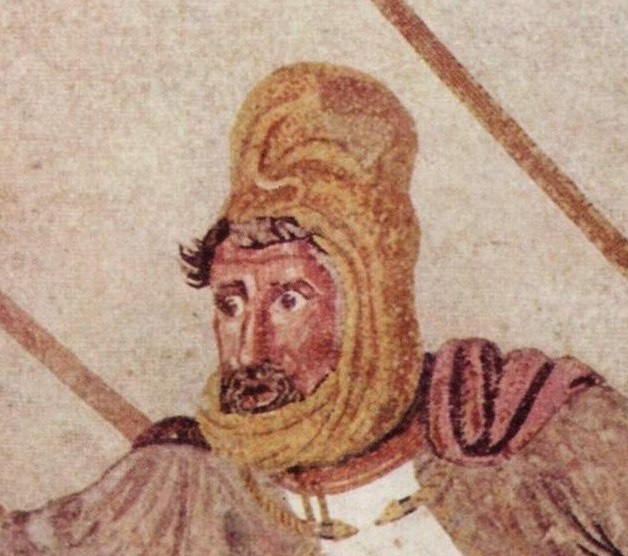“A great god is Ahuramazda, who created this earth, who created yonder sky, who created man, who created happiness for man, who made Darius king, one king of many, one lord of many.”
“I am Darius the Great King, King of Kings, King of countries containing all kinds of men, King in this great earth far and wide, son of Hystaspes, an Achaemenian, a Persian, son of a Persian, an Aryan, having Aryan lineage.”

Darius I Hystaspes, or Darius the Great, king of Persia was the son of Hystaspes, the satrap (provincial governor) of Parthia. The principal contemporary sources for his history are his own inscriptions, especially the great trilingual inscription on the Bisitun (Behistun) rock at the village of the same name, in which he tells how he gained the throne. The accounts of his accession given by the Greek historians Herodotus and Ctesias are in many points obviously derived from this official version but are interwoven with legends.
Darius is noted for having united Persia after some years of disintegration. He completed the process of organizing the empire into 20 satrapies that Cyrus II “the Great” had started. He built highways, established a postal system and helped the economy by having coinage, weights and measures standardized. He sent expeditions to explore travel routes in neighbour countries, and he completed the canal from the Nile to the Red Sea.

According to Herodotus, Darius, when a youth, was suspected by Cyrus II the Great, (who ruled from 559 to 529 BCE), of plotting against the throne. Later Darius was in Egypt with Cambyses II, the son of Cyrus and heir to his kingdom, as a member of the royal bodyguard. After the death of Cambyses in the summer of 522 BCE, Darius hastened to Media, where, in September, with the help of six Persian nobles, he killed Bardiya (Smerdis), another son of Cyrus, who had usurped the throne the previous March. In the Bisitun inscription Darius defended this deed and his own assumption of kingship on the grounds that the usurper was actually Gaumata, a Magian, who had impersonated Bardiya after Bardiya had been murdered secretly by Cambyses. Darius therefore claimed that he was restoring the kingship to the rightful Achaemenid house. However, he had to fight against a number of other pretenders and rebels. It took more than a year (522-521 BCE) of hard fighting to put down revolts associated with Bardiya’s claim to the throne.
Almost every province of the empire was involved in the conflict, including Persia and, most particularly, Media. Darius finally emerged from the struggle the undisputed ruler of the Persian Empire. The story of his successes was engraved in three scripts and languages (Persian, Babylonian, and Elamite), accompanied by a sculptured relief, into a high rock wall of the Bisitun Mountain, a few miles east of modern Kermanshah.
Darius proved to be a strong and wise ruler. He was tolerant toward other religions and cultures, promoted learning, agriculture, forestation, and the construction of highways. He also built the great palace cities of Susa and Persepolis.
Darius followed an active expansionist policy. Campaigns to the east confirmed gains, probably made by Cyrus the Great, and added large sections of the northern Indian subcontinent to the list of Persian-controlled provinces. Expansion in the west began about 516 BCE when Darius moved across the Hellespont in campaign against the Scythians along the western and northern shores of the Black Sea. The Scythians adopted a “scorched-earth” & ambush policy, forcing Darius to retreat in good order and with only limited losses, back across the Hellespont.
The real strategic purpose behind this move was probably to disrupt and interrupt Greek trade with the Black Sea area, which supplied much grain to Greece, suggesting that expansion into mainland Greece was already on his mind.
Between 499 & 493 BCE many of the Ionian Greek cities rebelled, aided by Greeks from the mainland (notably Athens) and Islands. After initial setbacks, Darius finally, and ruthlessly, crushed these revolts.
By 492 BCE Darius had made his son-in-law (Mardonius) special commissioner to Ionia. Mardonius had recovered Persian Thrace and Macedonia, first gained in the campaign against the Scythians and lost during the Ionian Revolt.
Darius then turned his attention to the Greek city states that had aided the Ionians in their revolt.
There followed the Persian invasion of Greece, led by Mardonius, that resulted in Darius’ defeat at the Battle of Marathon late in the summer of 490 BCE.
The “Great King” was forced to retreat and to face the fact that the Greek problem, which had probably seemed to the Persians a minor issue on the western extremity of the empire, would require a more concerted and massive effort. Thus began preparations for an invasion of Greece on a grand, coordinated scale. These plans were interrupted in 486 BCE by two events: a serious revolt in Egypt, and the death of Darius.



